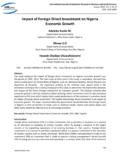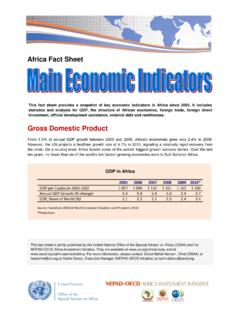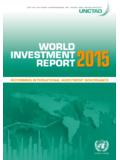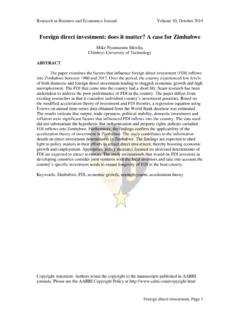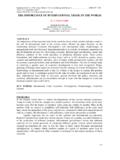Transcription of By: D. Ramesh s. Packialakshmi THE PROS AND CONS OF ...
1 Economy July 2014 facTS foR you 13By: D. Ramesh s. PackialakshmiTHE pros AND CONS OF foreign direct investment IN INDIA foreign direct Investments (FDIs) have given the Indian economy a tremendous boost. While India needs these investments to maintain a steady rate of economic growth, the government needs to tread with caution and ensure foreign investors do not take control of the Indian economy as a result of its liberalised policies. The country today needs a comprehensive and inclusive development strategy, which will use foreign direct investment to lift India s poor from their current state of deprivation. the rules of liberalisation, FDI comes through five routes. These are: the government (SIA/FIPB), RBI (auto-matic route), investment by NRIs, acquisition of shares, and equity shares of unincorporated bodies. To bridge the gap in the flow of funds in the public sector, more participation of the private sector is necessary.
2 For developing countries, foreign capital can be a good source foreign direct Invest-ment (FDI) refers to the net inflows of in-vestment to acquire a lasting management interest (10 per cent or more of vot-ing stock) in an enterprise operating in an economy other than that of the investor. It is the sum of equity capital, other long-term capital, and short-term capital as shown in the balance of payments. It usually in-volves participation in management, joint ventures, transfer of technol-ogy and expertise. There are two types of FDI: inward foreign direct investment and outward foreign di-rect investment , resulting in a net FDI inflow (positive or negative) and stock of foreign direct investment , which is the cumulative number for a given period. direct investment ex-cludes investment through purchase of shares.
3 FDI is one example of in-ternational factor direct investment refers to investment in a foreign country where the investor retains control over the investment . It typically takes the form of starting a subsidi-ary, acquiring a stake in an existing firm, or starting a joint venture in the foreign country. In India, as per of funds. It may involve equity par-ticipation by foreigners as: (i) direct investment , and (ii) portfolio invest-ment. DefinitionForeign direct investment (FDI) plays an extraordinary and growing role in global business. It can provide an organisation new markets and marketing channels, cheaper produc-tion facilities, access to new technol-ogy, product skills and financing. For a host country or the foreign firm that receives the investment , it can provide a source of new technologies, capital, processes, products, organi-sational technologies and manage-ment skills, and as such can provide a strong impetus to economic devel-opment.
4 foreign direct investment , in its classic definition, is defined as a company in one country making a physical investment into building a factory in an-other country. The direct investment in buildings, machinery and equipment is in contrast with mak-ing a portfolio investment , which is considered an in- direct investment . Economy 14 facTS foR you July 2014 recent years, given the rapid growth and change in global invest-ment patterns, the definition has been broadened to include the ac-quisition of a lasting management interest in a company or enterprise outside the investing firm s home country. As such, it may take many forms, such as a direct acquisition of a foreign firm, construction of a facility, or investment in a joint ven-ture or strategic alliance with a local firm with attendant input of tech-nology and licensing of intellectual property.
5 In the past decade, FDI has come to play a major role in the interna-tionalisation of business. Reacting to changes in technology, growing liberalisation of the national regu-latory framework governing invest-ment in enterprises and changes in capital markets, profound changes have occurred in the size, scope and methods of FDI. New information technology systems and a decline in global communication costs have made management of foreign invest-ments far easier than in the past. The sea change in trade and invest-ment policies and the regulatory en-vironment globally in the past dec-ade, including trade policy and tariff liberalisation, easing of restrictions on foreign investment and acquisi-tion in many nations, and the de-regulation and privatisation of many industries, have probably been the most significant catalysts for FDI s expanded role importance of FDIFDI plays a very important role in the development of an economy due to a number of reasons, some of which are listed below:1.
6 Helps to avoid foreign govern-ment pressure for local Aids in circumventing trade barriers, hidden and Enables making the move from domestic export sales to a local-ly-based national sales Helps in increasing the total production Presents greater opportuni-ties for co-production, joint ventures with local partners, joint marketing arrangements, licensing, inflows: Category-wiseTable I presents the category-wise direct investment inflows to India, which increased from US$ 3137 mil-lion in 2003-04 to US$ 19,819 million in 2012-13. Net portfolio investment flows to India increased from US$ 11,355 million in 2003-04 to US$ 26,891 million in 2012-13. Net for-eign investment in India increased from US$ 14,492 million to US$ 46710 million over the same period. FDI inflows: Country-wise Table II shows the country-wise break-up of FDI.
7 Mauritius emerged as the most dominant source of in-flows with a contribution of US$ 57,645 million ( per cent), fol-lowed by Singapore with a contribu-tion of US$ 15,683 million ( per cent) and USA with a contribution of US$ 8759 million ( per cent) during the period 2003-04 to 2012-13. One possible explanation for the dominance of Mauritius in FDI is that India has a Double Taxation Avoidance Agreement (DTAA) with Table I foreign direct investment : category-wise (US$ million)Item 2003-04 2004-05 2005-06 2006-07 2007-08 2008-09 2009-10 2010-11 2011-12 2012-13 foreign investment , Net (A+B) 14,492 13,000 15,528 14,753 44,957 5785 50,362 42,127 39,231 46,710A. direct investment of which: 3137 3713 3034 7693 15,401 19,816 17,966 11,834 22,061 19,819(i) In India 4675 5987 8901 22,739 34,236 37,672 33,109 29,029 32,952 26,953 Equity 2387 3714 5915 16,394 26,758 27,863 22,905 15,737 22,833 16,032 Re-invested earnings 1800 1904 2760 5828 7168 9032 8669 13,102 8205 9880 Other capital 488 369 226 517 310 776 1535 191 1914 1041(ii)
8 Abroad 1538 2274 5867 15,046 18,835 17,855 15,143 17,195 10,892 7134 Equity 282 1637 3766 12,604 14,421 13,688 9871 8048 3874 1614 Re-invested earnings 1176 248 1092 1076 1084 1084 1084 1569 1208 1189 Other capital 80 389 1009 1366 3330 3083 4188 7578 5809 4331B. Portfolio investment 11,355 9287 12,494 7060 29,556 14,031 32,396 30,293 17,170 26,891 In India 11,377 9311 12,494 7004 29,394 13,854 32,376 31,471 17,409 27,770 Abroad 22 24 56 162 177 20 1179 239 878 Source: RBI, Annual Reports from 2003-2004 to 2012-2013 Economy July 2014 facTS foR you 15this country, under which investors from Mauritius are protected from taxation in India. FDI inflows: Sector-wiseTable III reveals the sector-wise break-up of FDI inflows in India from the period 2003-04 to majority of the inflows dur-ing the period 2003-04 to 2012-13 were in manufacture ( per cent), financial services ( per cent), construction ( per cent), business services ( per cent), electricity and other energy genera-tion, distribution and transmission ( per cent) and computer ser-vices ( per cent).
9 These facts can be verified from the Report of the World Bank on External Financing for Developing Countries . FDI in retailThe Indian government feels that FDI in retail will help farmers, create jobs, and benefit consumers by leading to an improved supply chain and lower prices. Prof. Jagdish Bhagwati, a noted economist, has strongly supported FDI in retail. His argument is that retailers in the unorganised sector may face some problems initially, but after some time, they are bound to gain. He has observed, The entry of multinational retailers may lower the sales increase for unorganised retailers, but it will not reverse their growth in the near future. (See Un-tenable Critiques of Retail Liberalisa-tion , The Economic Times, October 15, 2012.) He feels that we have to learn from the Japanese experience.
10 Prof. Bhagwati has said that the farm sector is going to benefit from FDI in retail. According to him, In-dian farmers typically earn a third instead of the international norm of two-thirds of the final price of their produce, either because of wastage or because of exploitation by mid-dlemen. This situation will improve with FDI in the retail sector. The Indian cold chain market has the potential to grow to ` 320 billion by 2015 from around ` 185 billion in 2010-2011, according to a pitfalls. Critics of FDI in retail say the move will displace farmers, create unemployment and will leave consumers at the mercy of a powerful cartel known for its tough bargaining power. The move will distort the existing economic harmony in unorganised retail, dis-mantle the economic spine of the country, and enrich corporate capital but impoverish India s social capi-tal, said S.
